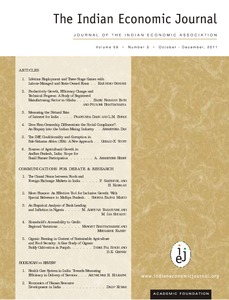Sources of Agricultural Growth in Andhra Pradesh, India: Scope for Small Farmer Participation
Abstract
Andhra Pradesh (AP) is one of the largest states in India, with agriculture providing the major source of income for about 60 per cent of the population even though it contributes only 19 per cent state GDP. In the last 40 years, annual growth rate of agriculture is 2.88 per cent as against targetted growth of about 4 per cent per annum. This paper analyses the sources of crop sub-sector growth in pre-liberalisation period (from 1970-1989) and post-liberalisation period (from 1990-2009). The growth rate in value of production in pre-liberalisation period is lower (2.4% per annum) than post-liberalisation period (2.7% per annum) per annum. Even though contribution of both yield and crop diversification to growth in value of production is higher, the negative contribution of real prices is the main reason for slower growth in preliberalisation period. While positive contribution of prices along with yield and diversification in the post-liberalisation period contributed for higher growth rate. In the post-liberalisation period, regions are specialising based on their resource endowment (coastal Andhra in paddy, Telangana in cotton and Rayalaseema in groundnut), even though all the regions show general tendency of diversification towards high value crops (HVCs) like fruits and vegetables. The paper highlights that the small farmer’s participation in diversification towards HVCs (HVCs; fruits, vegetables, spices, cotton and sugarcane) is limited, but they adopted the yield increasing technology components like high yielding varieties (HYVs), irrigation and cropping intensity compared to large farmers. As a result gross and net returns per ha are higher among small farms. This might have positive effect on small farmers (<2.0 ha) who comprise 86 per cent of the total farm households, and cultivate, on average, half a hectare of land. The paper also demonstrates that there is positive association between reduction of poverty and area under HVCs. Agricultural diversification in favour of HVCs that generate larger returns and are labour-intensive, which are demand driven to be explored for the benefit of small farmers. In many agricultural development indicators, coastal Andhra is better positioned followed by Telangana and Rayalaseema

